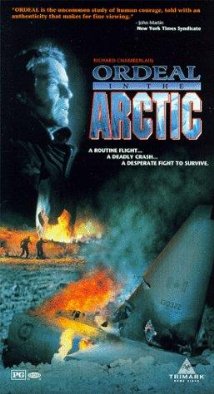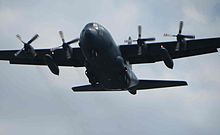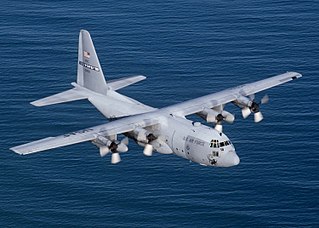
The Lockheed C-130 Hercules is an American four-engine turboprop military transport aircraft designed and built by Lockheed. Capable of using unprepared runways for takeoffs and landings, the C-130 was originally designed as a troop, medevac, and cargo transport aircraft. The versatile airframe has found uses in other roles, including as a gunship (AC-130), for airborne assault, search and rescue, scientific research support, weather reconnaissance, aerial refueling, maritime patrol, and aerial firefighting. It is now the main tactical airlifter for many military forces worldwide. More than 40 variants of the Hercules, including civilian versions marketed as the Lockheed L-100, operate in more than 60 nations.

The Lockheed HC-130 is an extended-range, search and rescue (SAR)/combat search and rescue (CSAR) version of the C-130 Hercules military transport aircraft, with two different versions operated by two separate services in the U.S. armed forces.

Alert, in the Qikiqtaaluk Region of Nunavut, Canada, is the northernmost continuously inhabited place in the world. The location is on Ellesmere Island at latitude 82°30'05" north, 817 km (508 mi) from the North Pole. It takes its name from the Royal Navy vessel HMS Alert, which wintered 10 km (6.2 mi) east of the present station off what is now Cape Sheridan in 1875–1876.

Bernt Balchen was a Norwegian pioneer polar aviator, navigator, aircraft mechanical engineer and military leader. A Norwegian native, he later became an American citizen and was a recipient of the Distinguished Flying Cross.

The Italia was a semi-rigid airship belonging to the Italian Air Force. It was designed by Italian engineer and General Umberto Nobile who commanded the dirigible in his second series of flights around the North Pole. The Italia crashed in May 1928, with one confirmed fatality from the crash, one fatality from exposure while awaiting rescue, and six missing crew members who were trapped in the still-airborne envelope. At the end of the rescue operations there were a total of 17 dead and a number of survivors.
Sergeant Keith Paul Mitchell, CV, MMM, MSM, CD, a Search and Rescue technician with 413 Search and Rescue Squadron in the Canadian Forces, received the Cross of Valour, the highest Canadian award for acts of courage in circumstances of extreme peril, on September 18, 1998, along with Master Corporal Bryan Keith Pierce.
Alert Airport is located at Alert, Nunavut, Canada, approximately 830 km (520 mi) south of the true North Pole. It is operated by the Canadian Department of National Defence and is part of Canadian Forces Station Alert. A weather station was established on the site in 1950, and in 1957 construction began on the military facilities which are still in use as of 2024. It is the northernmost airport in the world, although not used by public scheduled flights.

Marten Hartwell was a German-Canadian bush pilot in the Canadian Arctic. On November 8, 1972, the plane that Hartwell was flying on a medical evacuation crashed. One passenger was killed on impact, another died shortly after, and the pilot had two broken ankles and could not walk. One passenger, a boy, David Pisurayak Kootook, survived the initial crash along with Hartwell but died after 23 days. The pilot was rescued after 31 days. Since the pilot was injured and unable to obtain local food, and emergency rations had run out, the pilot was forced to consume flesh from one of the dead passengers. At the time of his death he lived at Black River, Kings, Nova Scotia.
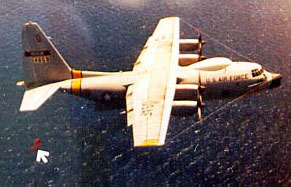
The Fulton surface-to-air recovery system (STARS), also known as Skyhook, is a system used by the Central Intelligence Agency (CIA), United States Air Force, and United States Navy for retrieving individuals on the ground using aircraft such as the MC-130E Combat Talon I and B-17 Flying Fortress. It involves using an overall-type harness and a self-inflating balloon with an attached lift line. An MC-130E engages the line with its V-shaped yoke and the person is reeled on board. Red flags on the lift line guide the pilot during daylight recoveries; lights on the lift line are used for night recoveries. Recovery kits were designed for one- and two-man retrievals.

Rescue swimmer is a qualification given to rescue specialists, most commonly in the service of the military. Rescue swimmers usually are charged with the rescue, assessment, and rendering of medical aid to persons in distress in the sea, on the land, or in the air. This highly specialized position is extremely challenging.

The Kee Bird was a United States Army Air Forces Boeing B-29 Superfortress, serial 45-21768, of the 46th Reconnaissance Squadron, that became marooned after making an emergency landing in northwest Greenland during a secret Cold War spying mission on 21 February 1947. While the entire crew was safely evacuated after spending three days in the isolated Arctic tundra, the aircraft itself was left at the landing site. It lay there undisturbed until 1994, when a privately funded mission was launched to repair and return it. During the attempted recovery, a fire broke out, resulting in the destruction and loss of the airframe on the ground.

The Cameroon Air Force is the air force of Cameroon. The Cameroon Air Force, along with the Cameroon Army, the Cameroon Navy, the National Gendarmerie, and the Presidential Guard make up the Cameroonian Armed Forces.

Lieutenant General Michael W. Wooley is a retired United States Air Force officer. He finished his career as the commander of the Air Force Special Operations Command (AFSOC), a component of the United States Special Operations Command. At the time of his retirement, the command included approximately 12,900 active-duty, reserve, Air National Guard, and civilian professionals.

The 210th Rescue Squadron is a unit of the Alaska Air National Guard 176th Wing located at Joint Base Elmendorf-Richardson, Anchorage, Alaska. The 210th is equipped with the HH-60G Pave Hawk helicopter.

Canadian Armed Forces Search and Rescue is the collective name used to refer to search and rescue (SAR) resources and operations within the Canadian Armed Forces (CAF). The Royal Canadian Navy (RCN) and Royal Canadian Air Force (RCAF) are jointly responsible for Canada’s SAR operations.
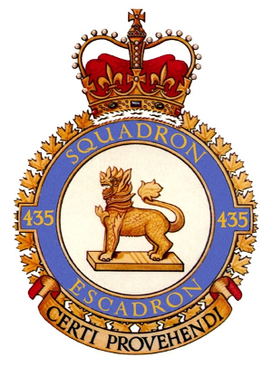
435 Transport and Rescue Squadron, nicknamed "Chinthe Squadron", is a Royal Canadian Air Force strategic transport, aerial refuelling and search and rescue unit based at Canadian Forces Base (CFB) Winnipeg in the province of Manitoba, Canada. The squadron flies four Lockheed CC-130H Hercules aircraft. In addition to being the only provider of tactical fighter air-to-air refuelling in Canada, the squadron is a provider of primary search and rescue response for the largest search and rescue region in Canada, controlled from CFB Trenton. The squadron keeps an aircraft on constant readiness to deploy, with airborne search and rescue technicians standing by to respond within 30 minutes of notification during weekdays and 2 hours at other times. The Trenton Search and Rescue Region, also covered by the 424 Transport and Rescue Squadron, extends from Quebec City to the Rocky Mountains, and from the Canada–United States border to the North Pole, covering most of Central, Western, and Northern Canada.
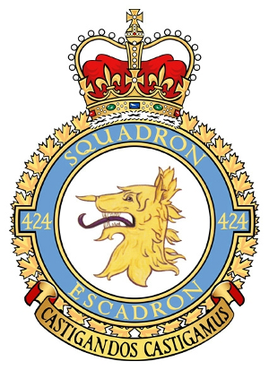
424 Transport and Rescue Squadron, nicknamed "Tiger Squadron", is a Royal Canadian Air Force strategic transport and search and rescue unit based at Canadian Forces Base (CFB) Trenton in the Canadian province of Ontario. The squadron is the primary provider of search and rescue response for the Trenton Search and Rescue Region, which extends from Quebec City to the Rocky Mountains, and from the Canada–United States border to the North Pole, covering an area of over ten million square kilometres in Central, Western, and Northern Canada.
The Joint Rescue Coordination Centre Trenton is a rescue coordination centre operated by the Royal Canadian Air Force (RCAF) and the Canadian Coast Guard (CCG). It is located on CFB Trenton in Astra, Ontario near Quinte West.

The 37th Helicopter Squadron is a United States Air Force unit assigned to the 582d Helicopter Group in support of the 90th Missile Wing located at Francis E. Warren Air Force Base, Wyoming. The unit is tasked with flight operations in support of the operation and security of F.E. Warren's intercontinental ballistic missile complex as well as search and rescue missions. The unit operates the UH-1N Huey helicopter.
